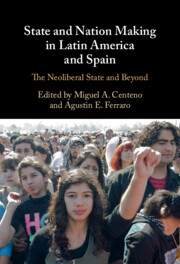Book contents
- State and Nation Making in Latin America and Spain
- State and Nation Making in Latin America and Spain
- Copyright page
- Dedication
- Contents
- Notes on Contributors
- Preface
- Part I Introduction
- Part II Economic and Territorial Power
- Part III Infrastructural Power: Reform Strategies
- Part IV Symbolic Power: Identities and Social Protest
- 11 Women Are the Social Face of the State
- 12 Europeanization Effects
- 13 Redefining Labor Organizing
- 14 Locating Neoliberalism in Abiayala
- 15 Resisting Neoliberalism? Territorial Autonomy Movements in the Iberian World
- Part V Conclusions
- Index
- References
13 - Redefining Labor Organizing
Coalitions between Labor Unions and Social Movements of Outsider Workers
from Part IV - Symbolic Power: Identities and Social Protest
Published online by Cambridge University Press: 03 August 2023
- State and Nation Making in Latin America and Spain
- State and Nation Making in Latin America and Spain
- Copyright page
- Dedication
- Contents
- Notes on Contributors
- Preface
- Part I Introduction
- Part II Economic and Territorial Power
- Part III Infrastructural Power: Reform Strategies
- Part IV Symbolic Power: Identities and Social Protest
- 11 Women Are the Social Face of the State
- 12 Europeanization Effects
- 13 Redefining Labor Organizing
- 14 Locating Neoliberalism in Abiayala
- 15 Resisting Neoliberalism? Territorial Autonomy Movements in the Iberian World
- Part V Conclusions
- Index
- References
Summary
In the last decades of the twentieth century, globalization, technological changes, and neoliberal reforms weakened labor organizations in Latin America and beyond. In this context, scholars not only documented labor union decline but also suggested that historical differences between formal-sector insiders (e.g., salaried workers) and outsiders (e.g., informal sector, rural, and unemployed workers) would deepen. However, unexpected alliances between labor unions representing insiders and social movements representing outsiders have since formed in a number of countries. Some of these alliances have crystallized into new national labor federations or overarching associations, which I call insider-outsider coalitions. I argue that these coalitions emerge in the context of major political or economic threats affecting labor movements. When labor movements split in response to such threats, defecting labor unions seek outsider allies. Coalition formation succeeds when defecting unions are strong and there are existing networks or organizations among outsiders. The chapter illustrates the argument of insider-outsider coalition formation in the case of Argentina.
- Type
- Chapter
- Information
- State and Nation Making in Latin America and SpainThe Neoliberal State and Beyond, pp. 411 - 427Publisher: Cambridge University PressPrint publication year: 2023



